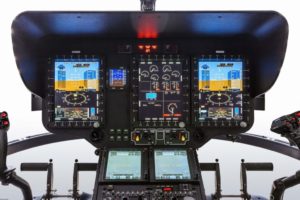
GRAND PRAIRIE, Texas – The world of avionics was a wholly different realm–one of steam gauges–when Vought Helicopters started operations in 1969 with just 17 Alouette II and III helicopters and 43 employees.
Today, that company, based here, has morphed into Airbus Helicopters North America with more than 3,100 aircraft–about 500 military and 2,600 civil–flying with nearly 800 operators. Examples of aircraft the company has built include more than 440 UH-72A Lakota helicopters for the U.S. Army, more than 100 H125s and H120s for U.S. Customs and Border Patrol, 100 U.S. Coast Guard MH-65 Dolphins, and seven AS350s, two H120s and one H145 for the Royal Canadian Mounted Police.
The company is growing with plans for a new $40 million Helisim simulation facility, including an H145 full flight simulator, to open next spring, and an H160 full flight simulator to debut at the facility in the near future.
As a whole, embedded/retrofit/repair avionics represents a significant part of Airbus Helicopters’ business. For example, the company said that it has just a six-day turnaround time on avionics systems at its MRO facility in Grand Prairie. And, in Columbus, Miss., the company has been fitting Cockpit Voice and Flight Data Recorders (CVFDR) on U.S. Army UH-72A Lakotas since last year at a rate of about three per month.
In the cockpit, the company continues to install the Helionix avionics suite–by Airbus and Elbit Systems–on the H135, H145, and H175, and, in the near future, the H160.
Introduced in December, 2013 after seven years of development, Helionix is “all about making the helicopter as safe as possible by reducing the work the pilot has to do,” said Romain Trapp, the president of Airbus Helicopters, Inc. and the head of the North American region. The bottom line is a helicopter does not fly by itself yet, but at the end of the day by making it more simple to fly, you’re making it safer.”
Airbus said that 360 helicopters are flying with Helionix worldwide.
Since 2017, Airbus has been selling Helionix Step 3, which includes two to four multifunction screens, a helicopter terrain avoidance and warning system (HTAWS), and a synthetic vision system with obstacle detection and real-time updates, including three-dimensional terrain maps. The system is to discard information not central to the pilot’s workload and to present only data that is relevant at given points in time, such as air traffic warnings, engine health, and flight obstacles.
Beside Helionix, Airbus Helicopters North America has begun installing the touch screen
Garmin [GRMN] 500H TXi on its H125 helicopters.
As for the standard, non-TXi Garmin 500H, “we still support it,” said Jessica Koss, a spokeswoman for Garmin. “We did stop selling new systems but plan to continue to support the G500H for the long term.”
While soft keys, such as those for the course deviation indicator (CDI), were once prevalent, the era of the touch screen continues, and pilots continue to have to adapt to the touch screen technology.
Learning how to use automation in the cockpit–“systems management”–has become vital to flying helicopters, said Tim McAdams, an Airbus instructor pilot who helped teach Tom Cruise how to fly helicopters for his role piloting an H125 in 2018’s Mission Impossible: Fallout.
This article was originally published in our sister publication Aviation Today.